Heidi Schwegler
All images and video by and courtesy of Heidi Schwegler.
Designed – Manufactured – Consumed – Tossed
Though ubiquitous, you’ve probably never thought about how polystyrene is made (a material frequently mistaken for Styrofoam). In the ‘pre-puff stage’, the polystyrene beads (around the size of a sugar crystal) are impregnated with a blowing agent called pentane, a gas that will puff the bead when steamed, very much like Jiffy popcorn. Following this is the actual ‘puff stage,’ during which the beads are inserted into a large cylinder that constantly agitates the material while steam is introduced. The heat causes the beads to expand to around 40 times their original size, creating the white puffy balls that are the signature characteristic of packing foam. Once cooled, they are put into a large form mold specific to the product that will be shipped. Heat is introduced and the beads fuse together into the shape.
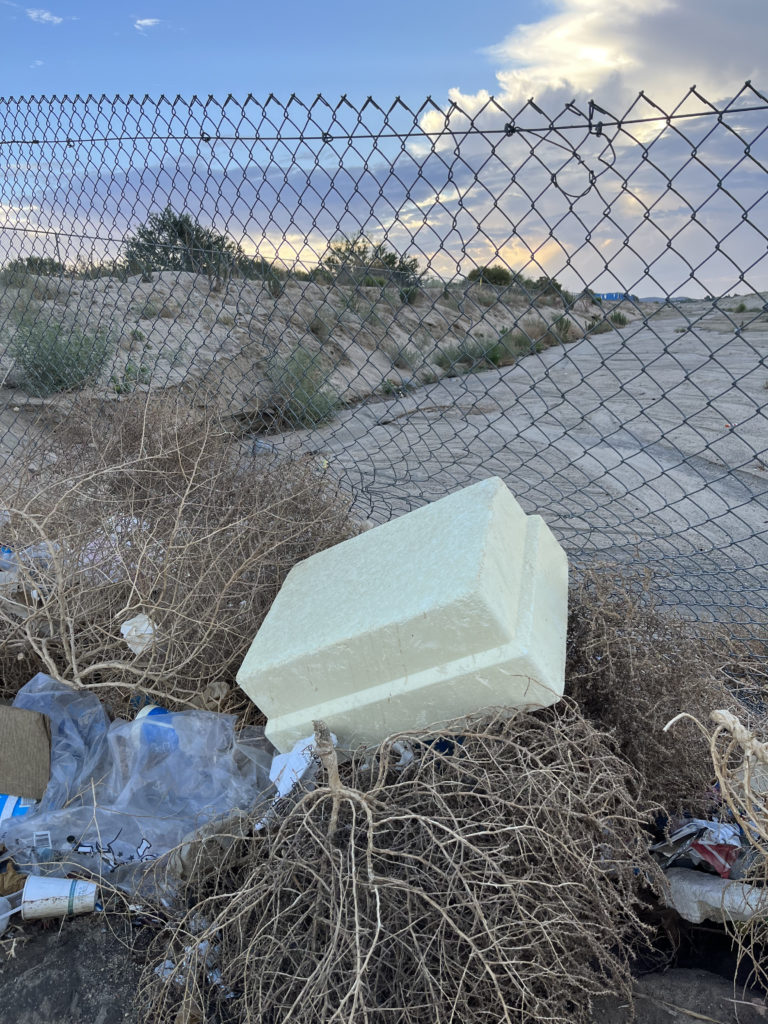
Property (Yucca Valley), 2022, still image.
The life of the resultant polystyrene foam is insanely short, as it merely acts in service to a newly purchased object. A pristinely white gridded sheet of foam cushions, carries and protects the double wide Samsung fridge as it’s shipped from manufacturer to your front door. Designed as supports for the “real” thing, the value of the foam is gone the minute the fridge is removed. An annoying barrier between the consumer and their desire, it is often ripped apart and kicked off to the side. To make matters worse, polystyrene is horribly expensive to recycle. Though it’s ideal for shipping at 95 percent air, it’s bulky and the processes it would take to convert it back to its original form is cost prohibitive.
Property (Yucca Valley), 2022, looping video.
Once shoved into the outdoor trash bin the Santa Ana winds in Southern California, particularly in the Mojave Desert, often force the packaging into flight. This doesn’t last long, however, as the desert is an eddy, full of all things pokey. The foam quickly finds the needles of a cholla or the daggers of a Joshua tree, where it is then destined to linger, flop and bake for the remainder of its physical existence.
That is, until I find it.
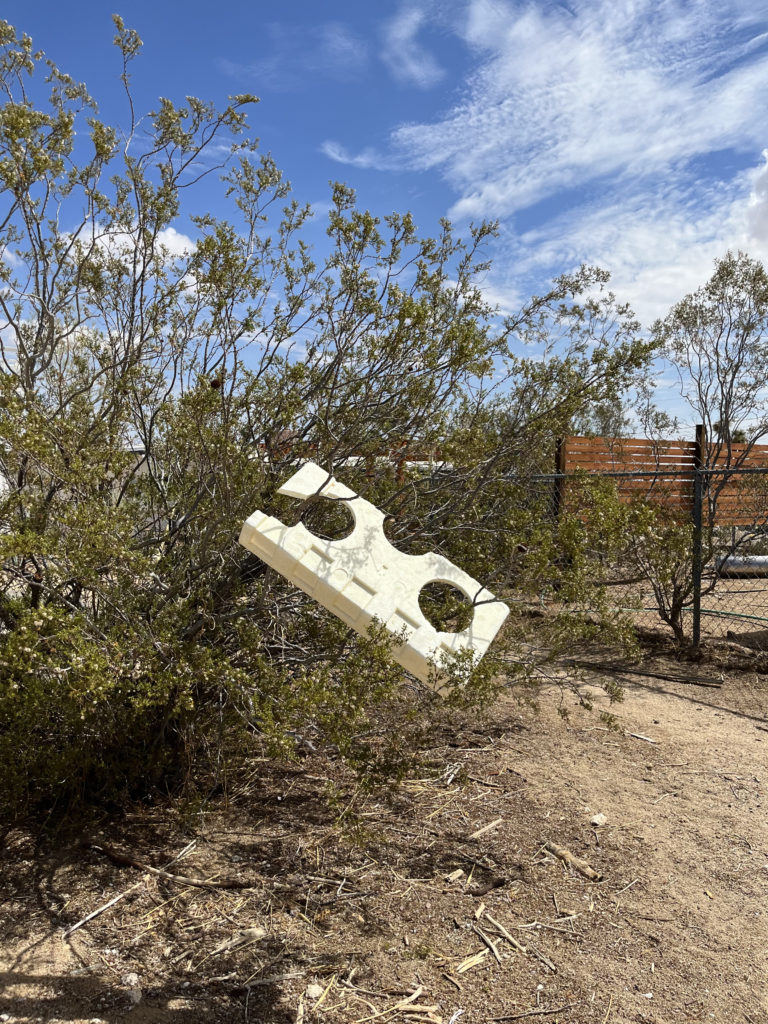
Property (Yucca Valley), 2022, still image.
Nature as Maker
When you really think about it, all making processes can be described as levels of pressure and resistance: how hard do I drop the hammer when forming a sheet of sterling silver, how much force does my thumb apply when sculpting clay, what angle is needed when dragging the file across the edge of wood. Most of what I do in the studio is alchemical, in that it has to do with how much directed force comes from my body into a material for aesthetic transformation.
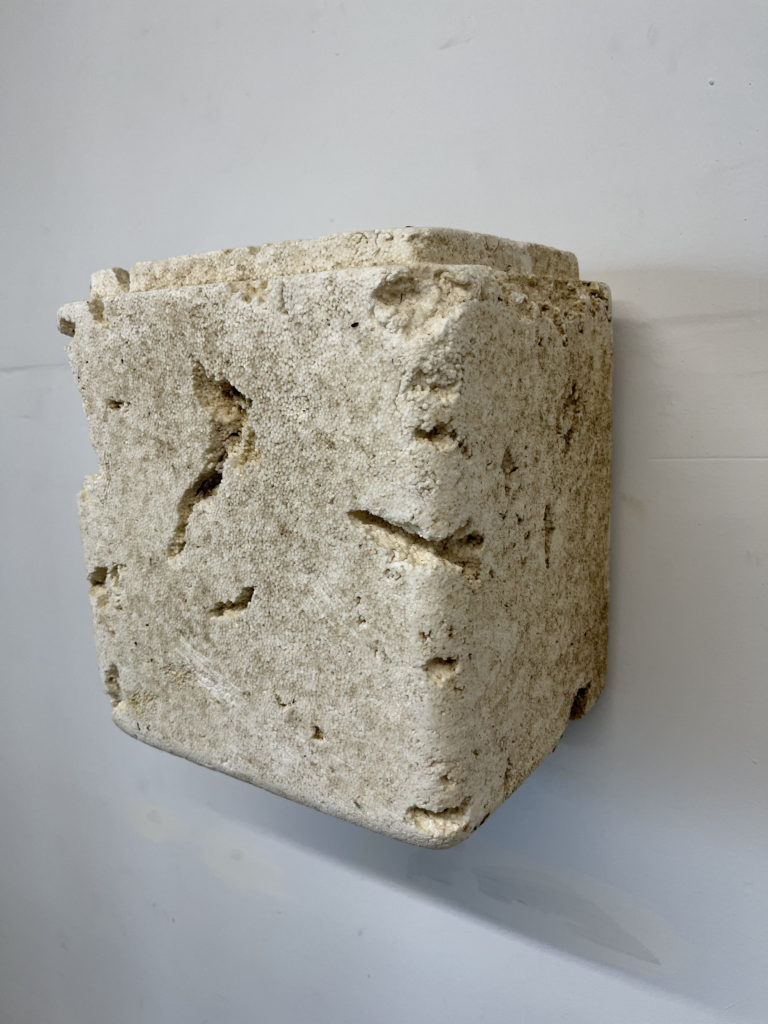
Property (Morongo Basin), 2022, still image.
When I come across stuff on the side of the road, I prefer to not see litter but rather something that is in the act of becoming. I am witnessing nature as a sort of unintentional craftsperson. The making process begins as soon as the object is tossed from the car window, hammered from the force of the fall, reshaped into a gentle contrapposto when run over by another vehicle, and subtractively sculpted and patinaed when exposed to the elements. Packing foam is packing foam and they all pretty much look alike: fused balls embossed with numbers, letters and arrows, pierced out graphic shapes and hygienically white. But when the fridge is removed and the foam no longer has purpose, damage begins to set in and nature grabs hold. This is when the foam fragments become one of a kind.
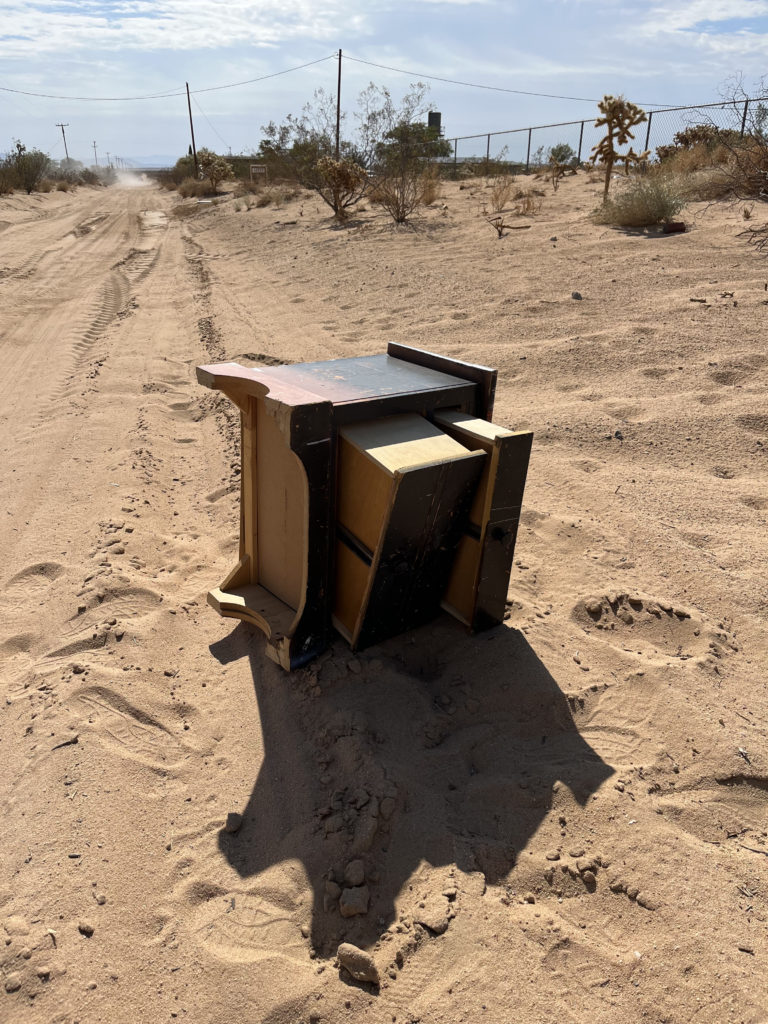
Property (Landers), 2022, still image.
The Ruin
Once something is made, we are forever tasked with stalling its natural tendency towards breakdown and disorder. Disconnected from use-value it may still exist in our world (like a ruin) but has been reduced to a mere presentation of the past. As German sociologist and philosopher George Simmel says: the ruin is “the site of life from which life has departed…..the present form of past life”[1]. Though it no longer does what it once did, it will remain tethered to the idea of that history until it is so fragmented it is no longer recognizable.
Creating a new thought for the discarded object can also underscore the implications of lost labor in the making of something that was never intended to be a fragment. In opposition to the robotic manufacturing of polystyrene, altering these found yellowing chunks with care and by hand has the potential to re-humanize the making process, and to add value to the value-less.
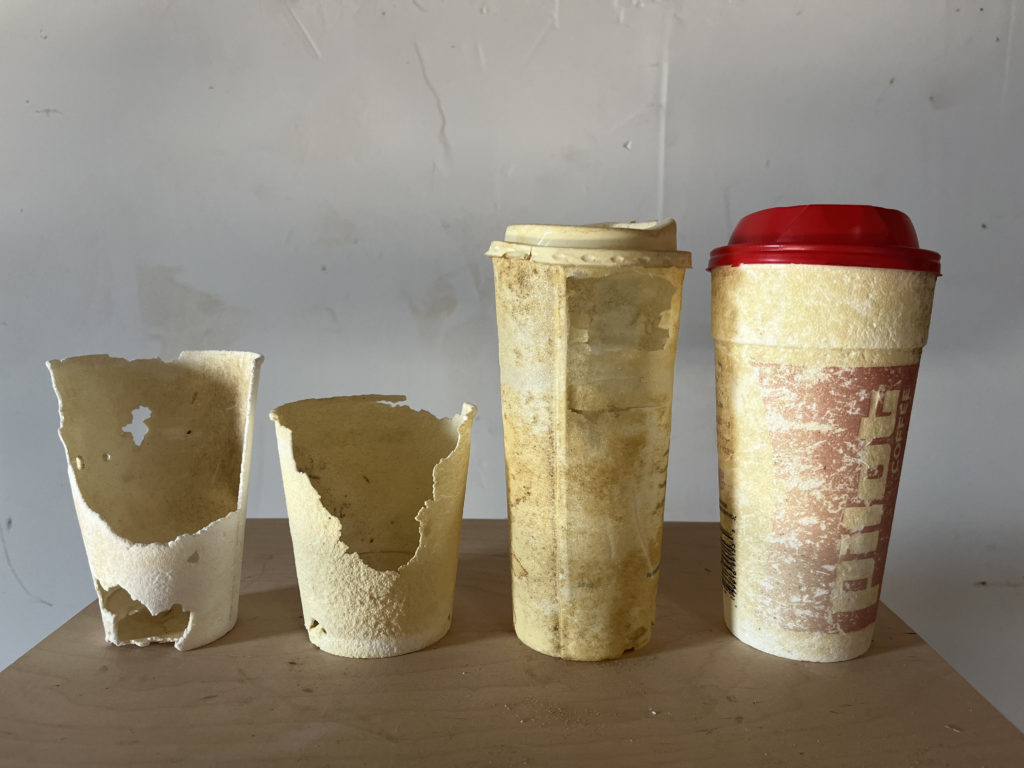
Property (Yucca Valley), 2022, still image.
Open Source Things
I’m less interested in what anything was designed to do, I’m more interested in what it can do by exploiting unintended capabilities. The project I am currently working on, “Future Ruins”, addresses the potential for aesthetic pleasure and conceptual content found in the discards of our everyday landscape. Surveying the ignored, the abandoned, and the ruined, I acknowledge that objects, whether art objects or otherwise, have been issued a conceptual death sentence the moment they enter the world. Broken down, tumbled in the desert, filed by a cactus and toasted by the sun, these discards become fragments of what they once were. Far from containing a diminished presence however, a shard can be as active as a phantom limb, alluding to a more imaginative wholeness than it would have as a complete form. The more ruined a recognizable thing, the more intense the provocation.
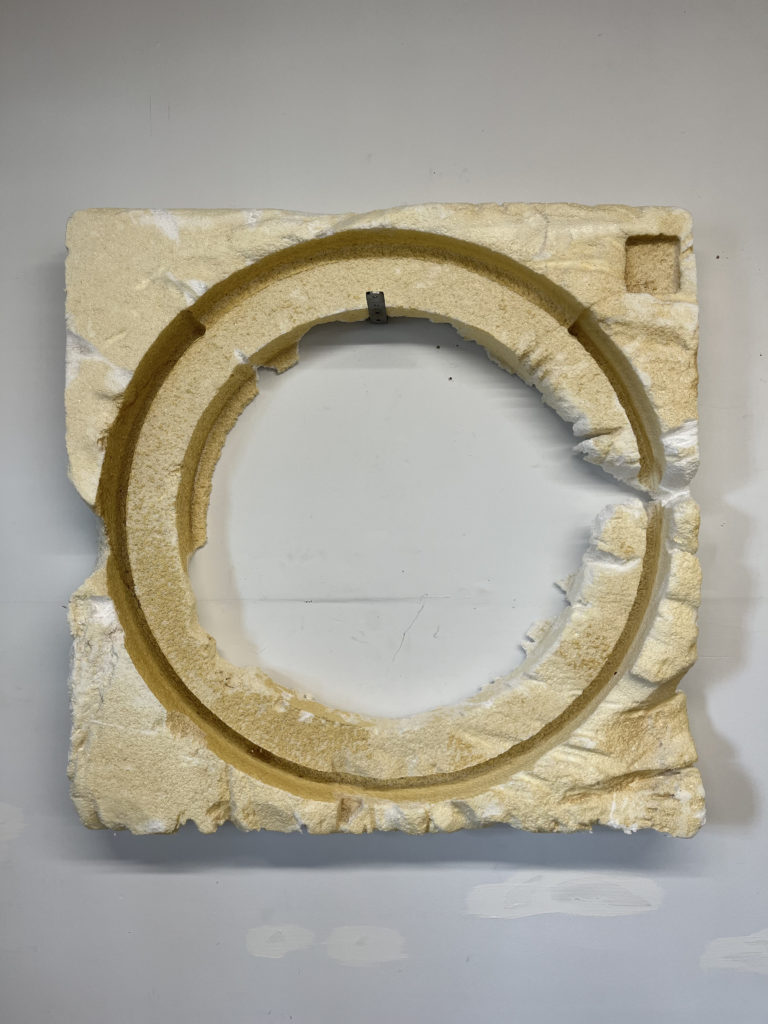
Property (Yucca Valley), 2022, still image.
Things break. They no longer do what they were designed to do. Surface damage and wear and tear are visual cues of a thing’s history and its former life. My work amends broken things by recasting and embellishing their materiality. I reproduce their original ordinariness and reorient their presence in terms of aesthetic value. Once formally presented, they ultimately allow you to ruminate on the future brokenness of your own body. As if bound through telepathy, your body becomes that object and that object becomes your body.
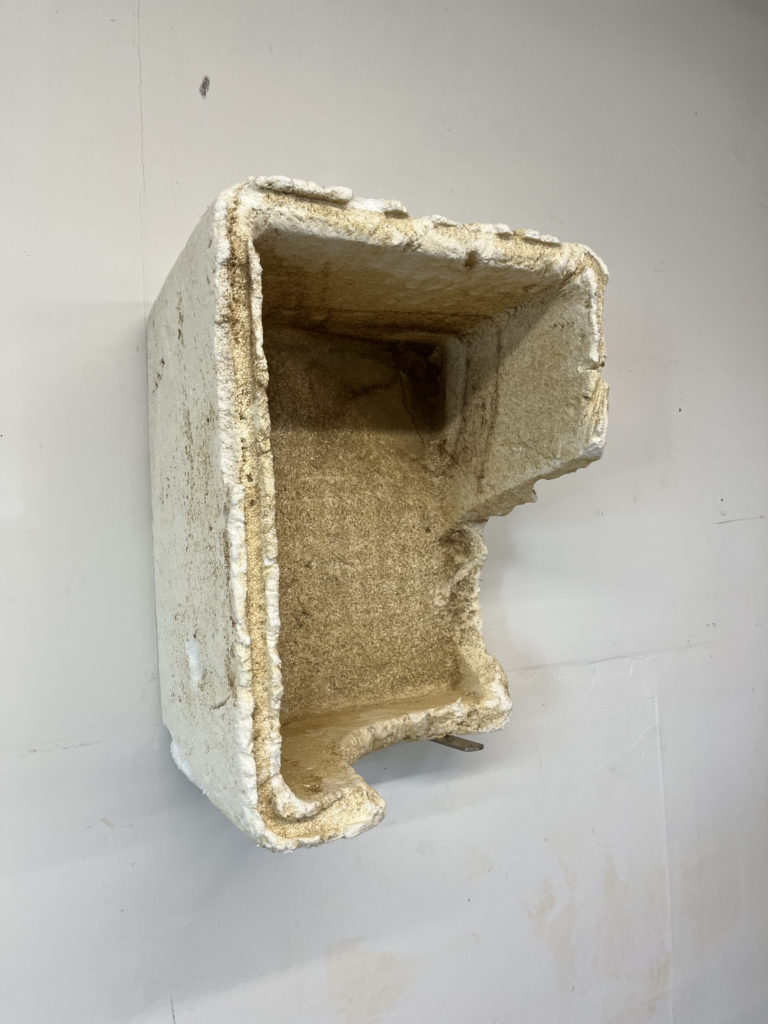
Property (Joshua Tree), 2022, still image.
Portions of Schwegler’s collection of Styrofoam forms will be presented at THE END Project Space in Atlanta, GE (Nov. 2022). Future Ruins is a two person show that will include work by Schwegler and Ofir Klemperer, Atlanta-based composer, improviser, singer, songwriter and producer.
[1] Simmel, Georg. 1959. The Ruin, in K.H. Wolff (ed.), Georg Simmel, 259 – 266, Columbus: The Ohio State University Press.
Heidi Schwegler works in the interstitial ruins of Beijing, Los Angeles, New York City and suburban America. She rescues haphazardly disused scraps from the bowels of the megalopolis: chicken bones, Big Gulps, broken signs, lost shoes, crumpled pylons, take out containers. Plastic, fiber, and bone: these materials decay but never decompose. A peerless craftsperson, she resynthesizes her sources into facsimiles with cast glass, gold, silver, wax, resulting in artwork that persists in a “living death.” Recent exhibition venues include WBG London Projects (London), Asphodel (New York), Sheldon Museum (Lincoln, NE), and the Portland Art Museum (Portland, Oregon). Schwegler is a Ford Family Fellow, a MacDowell Colony Fellow, and a Yaddo Artist-in- Resident. Reviews of Schwegler’s work have appeared in Art in America, Daily Serving, ArtNews, Modern Painters, and the Huffington Post. Schwegler is the founder of the Yucca Valley Material Lab, a platform for making and thinking.